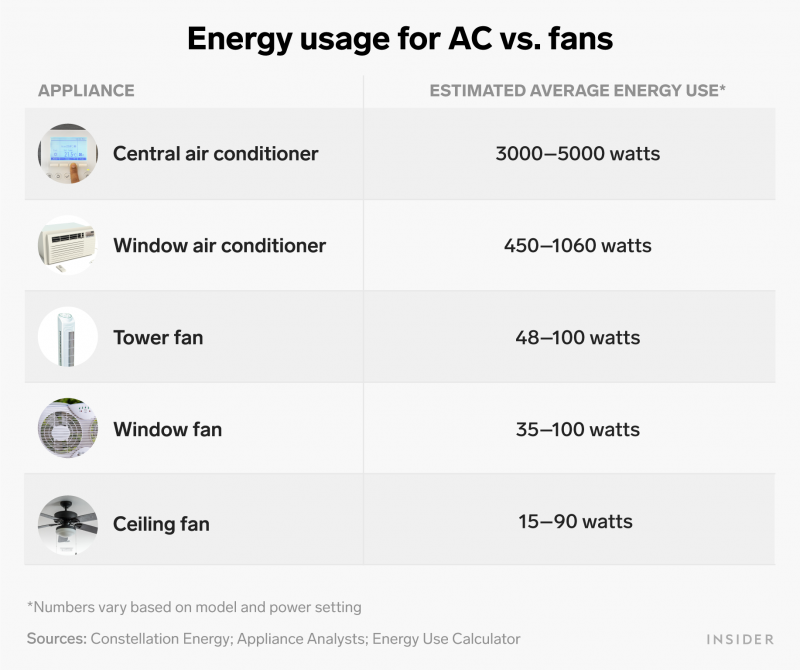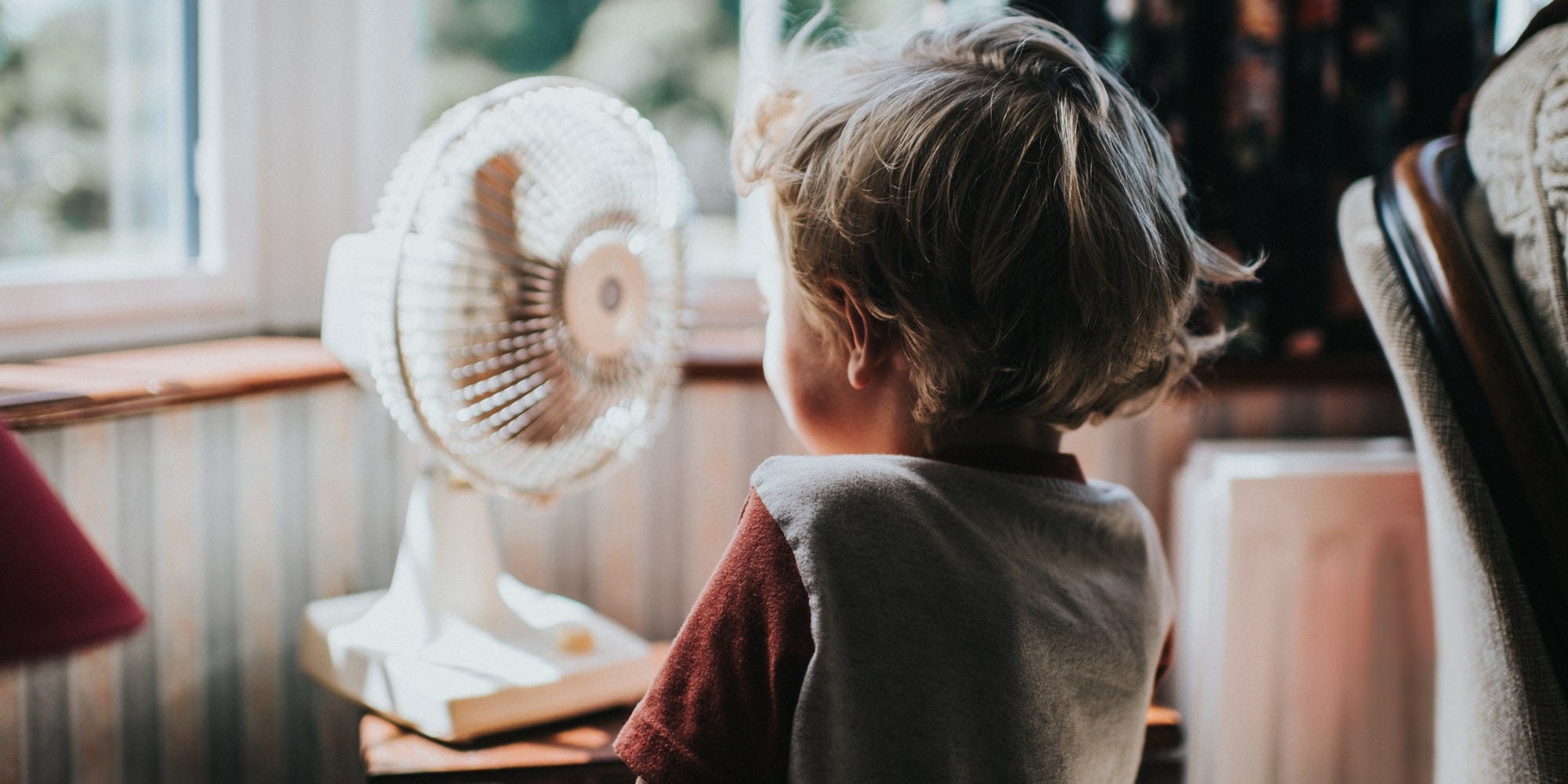- It’s possible to cool a room down and keep it cool without air conditioning.
- Fans can be more energy-efficient and cost-effective when compared to AC, and there are a few tips and tricks that can help you beat the heat with these appliances.
- Here’s how to use window fans, ceiling fans, and tower fans to get the most out of these cooling methods.
- This story is part of Insider’s guide to Heat Illness.
If you’re unable to invest in an air conditioner during the summer, you might want to consider using fans throughout your house to keep cool.
Fans are generally cheaper to buy and install than AC units. Plus, they are better for the environment because they use less energy.

All that energy adds up: AC costs homeowners about $29 billion each year, according to the United States Department of Energy (DOE). Fans are far more energy-efficient and cost-effective.
But fans only work effectively when you use them correctly. Here's a simple guide on how to use the different types of fans properly to keep cool at home.
Window fans

Window fans are installed in open windows to draw cold air in and push hot air out, and can be set up to cool an entire house. Here are three tips for how to use window fans most effectively.
Tip 1: Only turn them on when it's cooler outside than inside
In order for window fans to cool your home, the outdoor temperature must be lower than the indoor temperature. That's going to be at nighttime or early in the morning.
Don't run a window fan during the hottest part of the day because it will draw in the hot afternoon air, making your home warmer, not cooler.
Lastly, window fans are installed with a fitted sheet metal mounting that slots into an open window and seals around the edges. So, you don't have to worry about opening or closing that window.
However, other windows in your house should remain closed during the hottest part of the day and - when safe - open at night and early morning.
Tip 2: Use more than one fan to create a crosswind
Window fans work best when you use more than one to create a crosswind, which pushes the hot air out and draws the cool air in. To do this, setting the fans up in the right location is crucial.
- Fans blowing air into your house: "You want the cooler air to blow inwards, so place one fan or more on the coolest side of your home that sees lots of shade - this will ideally be on the north side which gets the most shade - facing in towards the house and away from the windows," says Nathan Kipnis, FAIA, founder of Kipnis Architecture and Planning and specialist in the sustainability and energy efficiency of architectural design.
- Fans pushing air out of your house: Then place an equal number of fans on the opposite side of your home facing out of your windows to push the hot air out. "Pushing air out on the south side is ideal," says Kipnis.
- Keep as many inside doors open as possible. This will help maximize airflow throughout the house.
Ideally you should have an equal number of fans pulling cool air in as pushing hot air out. However, if you have an odd number of fans, then it's generally better to have more fans pulling cool air in.
If you live in a multi-story home, place the inward-blowing fans on the lower floors where it's cooler and the outward-blowing fans on the upper floors. This method will rid your home of the warm air rising to the upper stories.
"So bringing air in low on the north side and pushing it out high on the south side is ideal," says Kipnis.
Ceiling fans

Ceiling fans circulate air in the room by pushing it down. However, they can not lower the temperature like a window fan or AC unit. But they can still cool you down.
That's because their breeze creates a slight wind chill effect that can help sweat evaporate from your skin, which cools you down. So, it's not your home that it's cooling, but rather your body.
Below are four tips for using ceiling fans to stay cool.
Tip 1: Make sure it's rotating counterclockwise
In the summer, make sure your fan is rotating counterclockwise. This will push the air straight down and create that wind chill effect.
In winter, it's best if your fan rotates the opposite direction: clockwise. That way, air is pushed upwards so heat can circulate and keep you warm.
This guide walks you through how to safely check and change the direction of your ceiling fan.
Tip 2: Turn it off when you leave the room
Make sure you turn ceiling fans off when leaving the room because they cool people, not rooms. It's a waste of energy to have them switched on if there is no one there to feel the wind chill effect.
Tip 3: Purchase energy-efficient models
If you are looking to buy a new ceiling fan, look for the ENERGY STAR® label since fans that earn that label are up to 60% more energy-efficient than non-certified fans. Here's a complete buying guide for ceiling fans from the US Environmental Protection Agency, which partners with the DOE to run the ENERGY STAR® program.
You can also purchase smart ceiling fans, which reduce energy costs by as much as 4% to 11%, according to US General Services Administration data.
Smart fans work by turning themselves off at optimal temperatures and by sensing when the room is empty. They also save energy by adjusting fan speed in response to temperature and humidity changes.
Tip 4: Combine with your AC unit
If you have a ceiling fan in the same room as an AC unit, it helps blow colder, air-conditioned air throughout the room. This can cut your energy consumption and reduce how hard your air-conditioner has to work.
"You could set your AC unit four degrees higher, combine it with a ceiling fan, and feel just as cool," says Kipnis. "And the key thing with AC is that it dehumidifies the air which is what helps make the fan even more effective."
It's worth noting that all ceiling fans work more effectively in dry air, "Because the sweat on your skin evaporates more quickly than if the air was humid, so you feel cooler," says Kipnis.
Tower fans

Tower fans are narrow, tall, and portable, meaning they easily fit into the corner of most rooms. They create air flow by oscillating from left to right.
Again, they work by creating a wind-chill effect rather than lowering the temperature of the room.
Tip 1: Use ice for extra cooling
If you're really struggling to stay cool, for instance, during the peak of the day when it's hottest outside, place a bucket of ice in front of your tower fan as a homemade AC unit. The ice cools the air pushed out by the fan, which then circulates around the room.
Another method for creating a homemade AC unit using your fan is described below:
- Freeze a large, empty plastic bottle (four pints or one-liter sized).
- Once frozen, place the empty bottle on a tray and cover it with a damp cloth.
- Position the tray in front of your fan, so the breeze gets extra cool from the frozen bottle.
Our colleagues at Insider Reviews have compiled a list of the best tower fans, as well as the best electric fans overall, if you're interested in purchasing a fan.
The bottom line
Fans can be an energy-efficient and cost-effective way to beat the heat during the summertime. But when temperatures are highest, they aren't as effective as air conditioners for staying cool.
For example, according to the Center for Disease Control (CDC), fans can provide comfort at temperatures less than 90°F, but they won't prevent heat-related illness when temperatures reach 90°F or higher.
In fact, according to one study, when temperatures are above 95°F, fans might actually make the room hotter. For more information on protecting yourself from heat during the summer, see our guide on how to stay cool without AC.

